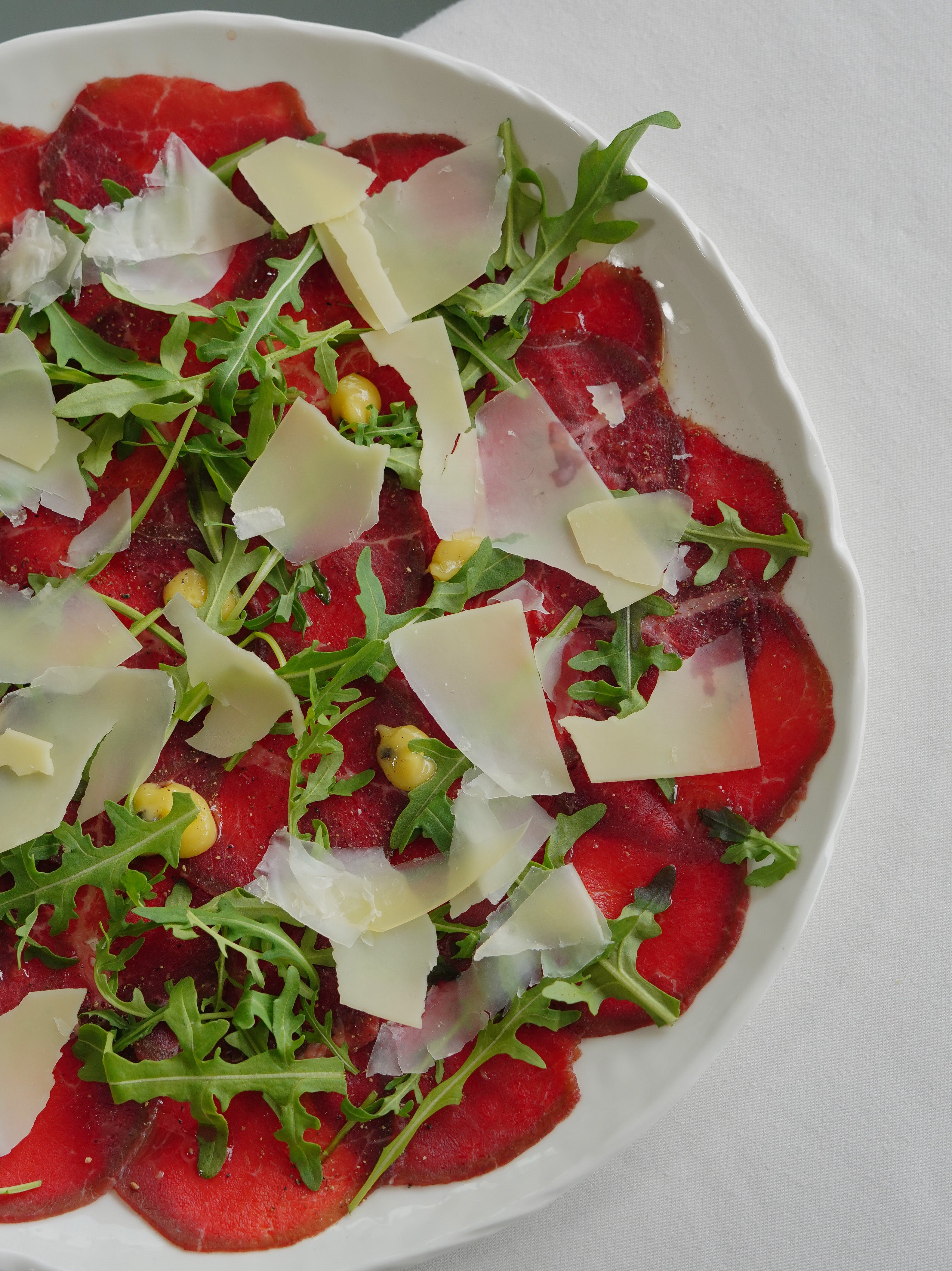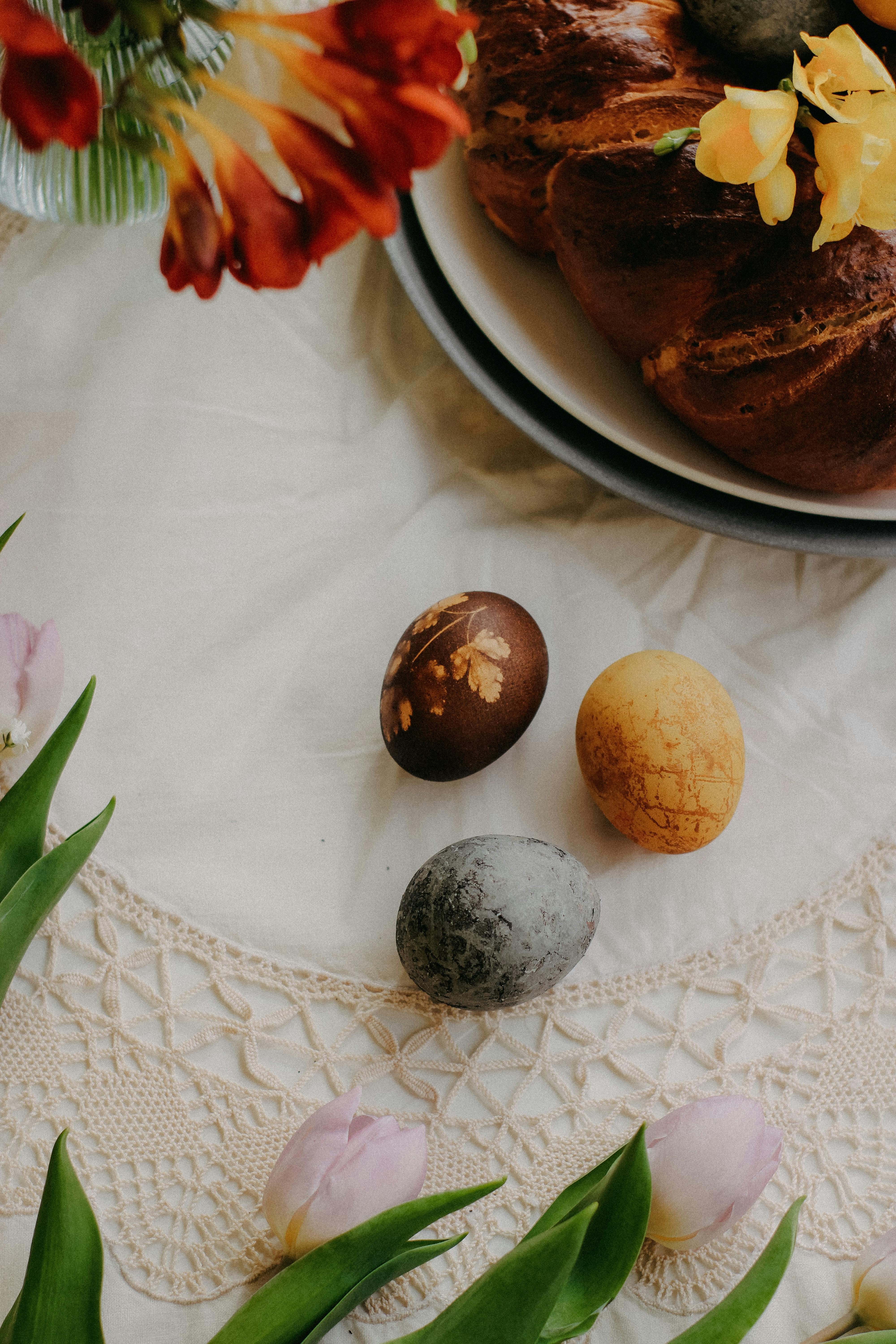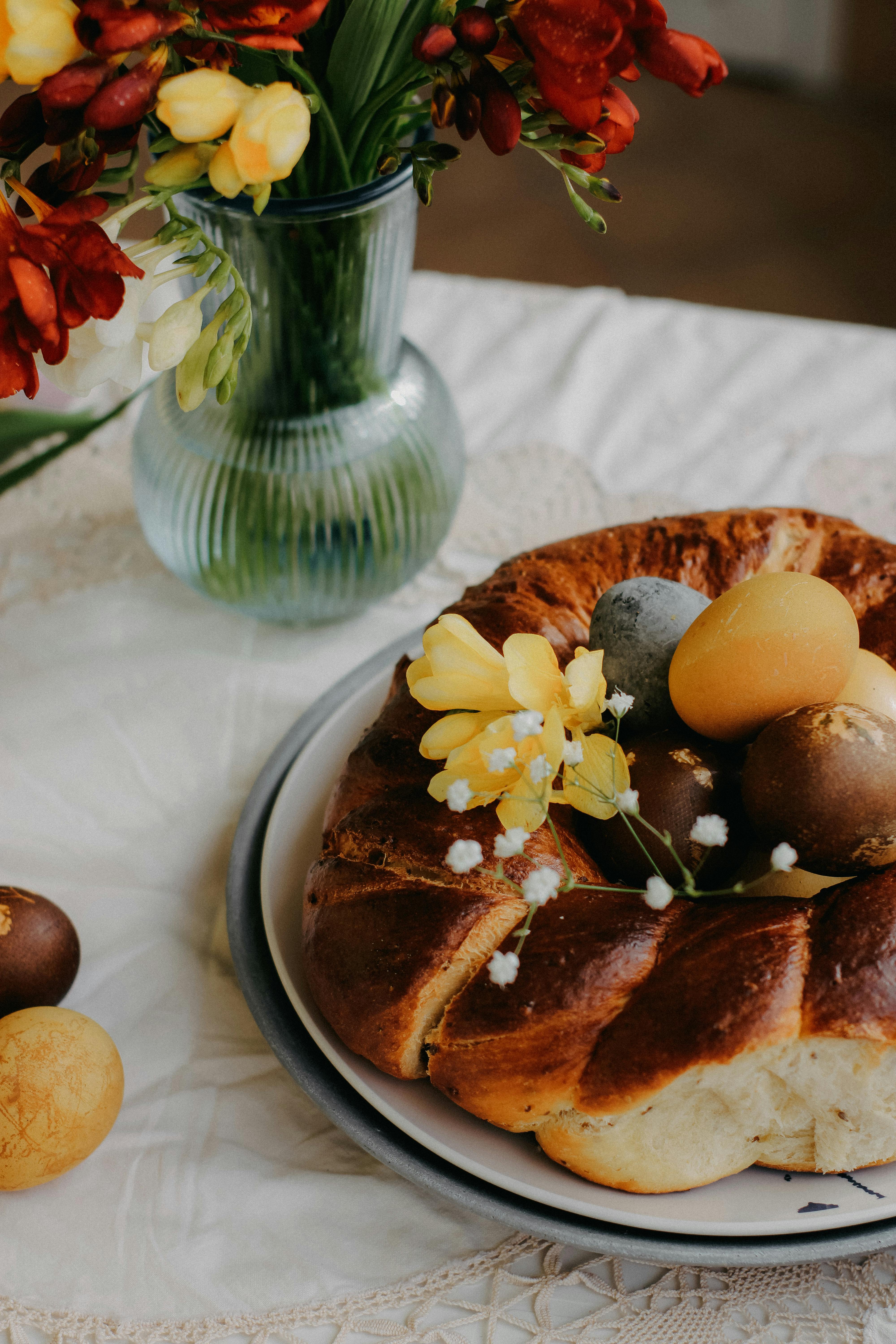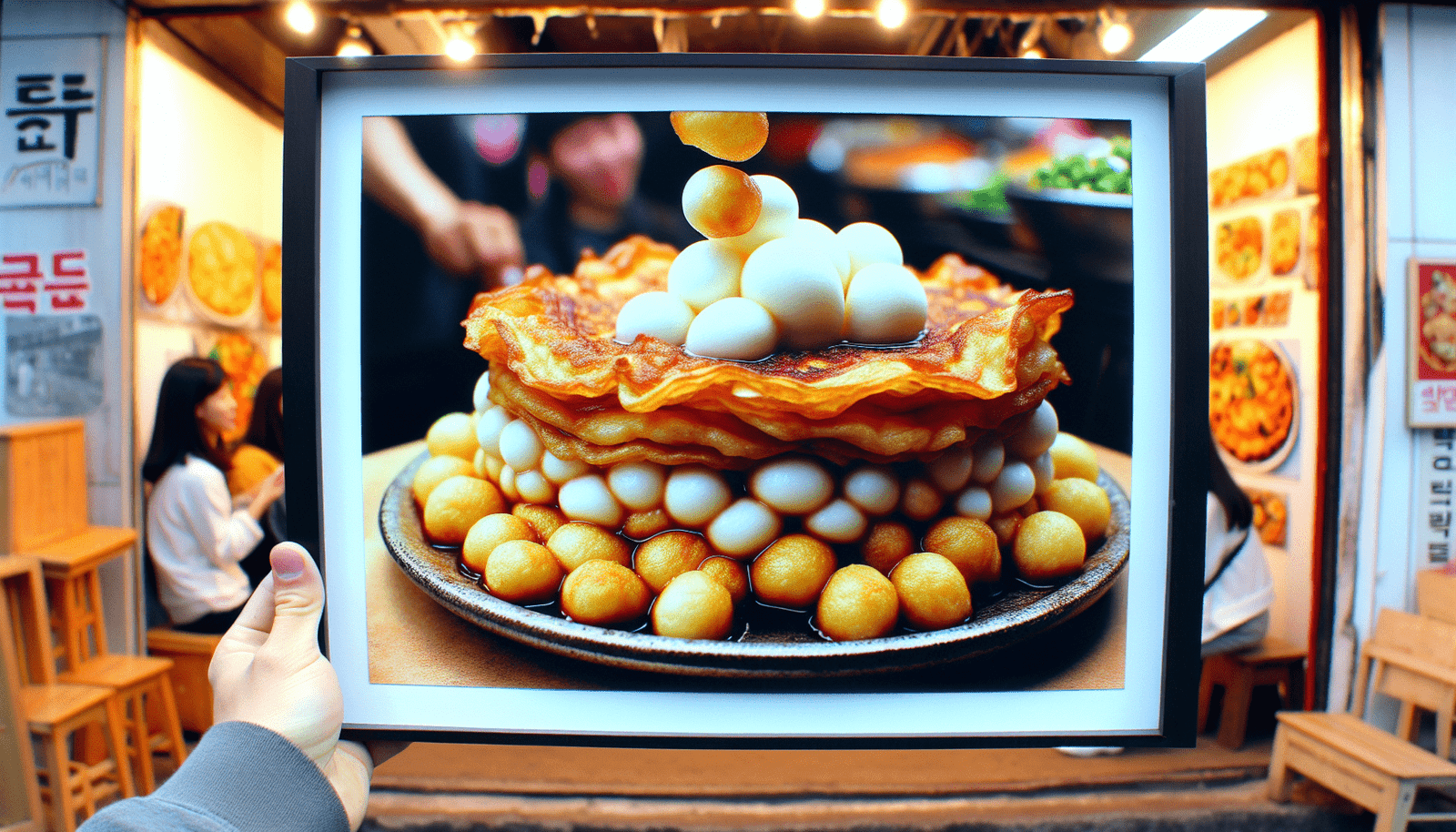If you’re planning a trip to Korea and looking forward to exploring its vibrant culinary scene, you’re in for a treat! The country is renowned for its diverse and delicious street food, which can be found in numerous food markets across the country. From the bustling streets of Seoul to the quaint alleys of Busan, these markets offer a tantalizing array of flavors that are sure to delight your taste buds. Whether you’re a fan of spicy dishes, savory snacks, or sweet treats, there’s something for everyone to enjoy. So, let’s take a virtual tour of some of the famous food markets in Korea and discover what mouthwatering delights await you!

Gwangjang Market
Bindaetteok (Mung Bean Pancake)
As you explore Gwangjang Market, a bustling traditional market in Seoul, make sure to treat yourself to a mouthwatering Bindaetteok, a savory Mung Bean Pancake. These pancakes are made by grinding mung beans and mixing them with vegetables, such as onions, green peppers, and bean sprouts. The batter is then pan-fried to a golden brown perfection, resulting in a crispy exterior and a soft, flavorful interior. Bindaetteok is often served with a soy-based dipping sauce that enhances its taste even further. Don’t be surprised if you find yourself coming back for seconds – these pancakes are addictive!
Mayak Gimbap (Drug Gimbap)
While strolling through the vibrant Gwangjang Market, get ready to taste a unique and addictive treat – Mayak Gimbap, also known as “Drug Gimbap” due to its addicting flavors. Mayak Gimbap is a smaller version of the traditional Korean rice roll, filled with various ingredients such as seasoned rice, carrots, pickled radish, and ham. Each roll is then coated in a delicious sesame oil sauce, which gives it a distinctive taste. The name “Mayak” refers to the addictive nature of these bite-sized delights, as they are so tasty that you’ll keep coming back for more.
Yukhoe (Korean Beef Tartare)
For the adventurous foodie, a visit to Gwangjang Market wouldn’t be complete without trying Yukhoe, a traditional Korean beef tartare. Made from high-quality beef, typically sirloin or tenderloin, Yukhoe is seasoned with soy sauce, sesame oil, minced garlic, and other flavorful ingredients. The dish is often garnished with a raw egg yolk and served with julienned Asian pear and toasted sesame seeds. The result is a dish that is both visually appealing and incredibly delicious. If you’re a fan of raw meat dishes, Yukhoe is a must-try when visiting Gwangjang Market.
Namdaemun Market
Hotteok (Sweet Korean Pancake)
Namdaemun Market, one of Korea’s oldest and largest traditional markets, offers a wide array of delectable street food options. One of the must-try delicacies at this bustling market is Hotteok, a popular sweet treat. Hotteok is made by kneading dough and filling it with a sweet mixture of brown sugar, cinnamon, and crushed peanuts. The dough is then fried until it becomes golden brown and crispy on the outside, while the sugar filling melts to create a gooey and indulgent center. The combination of textures and flavors makes Hotteok a delightful snack that will satisfy your sweet tooth.
Dakhanmari (Korean Chicken Soup)
If you’re in the mood for something warm and comforting, make your way to Namdaemun Market’s food stalls and indulge in Dakhanmari, a traditional Korean chicken soup. Prepared by simmering whole chickens with various herbs, vegetables, and spices, Dakhanmari boasts a rich and flavorful broth that is both nourishing and delicious. The tender chicken meat, along with the hearty vegetables, creates a soul-soothing dish that will warm you from the inside out. Whether you’re exploring Namdaemun Market on a chilly day or simply craving some traditional comfort food, Dakhanmari is a must-try.
Bungeoppang (Fish-shaped Pastry)
As you wander through the vibrant Namdaemun Market, keep an eye out for Bungeoppang, a delightful fish-shaped pastry that is sure to catch your attention. Bungeoppang is made by pouring a sweet batter into fish-shaped molds and filling them with various fillings, such as sweet red bean paste, custard cream, or Nutella. The pastries are then cooked until they are golden brown and crispy on the outside, while the fillings melt to create a gooey and irresistible center. Bungeoppang not only satisfies your sweet tooth but also makes for a fun and Instagram-worthy treat.
Noryangjin Fish Market
Sannakji (Live Octopus)
If you’re feeling adventurous and eager to try something truly unique, head to Noryangjin Fish Market and brace yourself for a culinary adventure with Sannakji, live octopus. Sannakji is prepared by slicing a fresh octopus into bite-sized pieces and serving them immediately. The thrill comes from the fact that the octopus is still moving, creating a truly unforgettable dining experience. Chewy and slightly sweet, Sannakji is typically enjoyed by dipping it in a sesame oil-based sauce before taking a bite. It may be a challenge for some, but trying Sannakji is an opportunity to step out of your culinary comfort zone and immerse yourself in Korean seafood culture.
Grilled Fish
At Noryangjin Fish Market, you can also savor the incredible flavors of freshly caught fish prepared simply yet expertly. Grilled fish is a staple dish in Korean cuisine, and Noryangjin Fish Market is the perfect place to taste this flavorful delight. You can choose from a variety of fish, such as mackerel, flounder, or sea bass, which are then seasoned with salt and grilled to perfection. The result is a fish that is moist, tender, and bursting with natural flavors. Pair it with a side of steamed rice and some spicy Korean dipping sauce, and you have a delectable meal that showcases the freshness of the seafood.
Maeuntang (Spicy Fish Stew)
For those who prefer their seafood with a kick, a bowl of Maeuntang at Noryangjin Fish Market is a must-try. Maeuntang is a spicy fish stew that features a flavorful broth made by simmering fish, vegetables, and Korean spices. The stew is known for its vibrant red color and bold, spicy taste. The fish used in Maeuntang can vary, but popular choices include red snapper, cod, or pollack. The combination of tender fish, an aromatic broth, and fiery spices creates a dish that will warm your soul and leave you craving more. Don’t forget to pair it with a bowl of rice to balance out the heat.
Tongin Market
Dosirak (Traditional Lunchbox)
Step into the nostalgic ambiance of Tongin Market and experience a taste of the past with Dosirak, a traditional Korean lunchbox. Dosirak consists of various side dishes, such as rice, Kimbap (rice rolls), Japchae (glass noodles), Tteok (rice cake), and a selection of seasoned vegetables. The lunchbox is served in a metal tray with multiple compartments, allowing you to enjoy a well-rounded and satisfying meal. One unique characteristic of Dosirak at Tongin Market is the use of traditional brass coins. Instead of using cash, you exchange these coins for your desired side dishes at the different food stalls within the market. Dosirak offers not only a delicious meal but also a cultural experience.
Sundae (Blood Sausage)
Tongin Market is renowned for its Sundae, a Korean blood sausage that is sure to excite your taste buds. Sundae is made by stuffing pig intestines with a mixture of glutinous rice, vegetables, and various seasonings. After steaming or boiling, the sausage is sliced into bite-sized pieces and served with a side of salt and gochujang (Korean chili paste) for dipping. The combination of the chewy and slightly sticky rice with the savory and rich flavors of the sausage creates a unique and satisfying culinary experience. If you’re feeling adventurous, don’t miss out on the opportunity to try this quintessential Korean street food.
Gireum Tteokbokki (Fried Tteokbokki)
Indulge in a crispy and delicious twist on the beloved Korean street food classic – Gireum Tteokbokki – at Tongin Market. Tteokbokki, a dish made with chewy rice cakes cooked in a spicy and sweet Korean chili paste sauce, is a popular choice among locals and visitors alike. At Tongin Market, you can experience a unique version of this dish. Gireum Tteokbokki is prepared by deep-frying the rice cakes until they become golden and crispy, then tossing them in a glossy and slightly spicy sauce. The result is a delightful combination of textures, with the outer layer adding a satisfying crunch to the soft and chewy rice cakes. Gireum Tteokbokki is a must-try for those seeking a delicious and satisfying street food experience.

Jagalchi Market
Guljeon (Korean Oyster Pancake)
Jagalchi Market, Korea’s largest seafood market located in Busan, offers an incredible variety of seafood delicacies. One standout dish that you simply can’t miss is Guljeon, a savory Korean oyster pancake. Made by mixing fresh oysters with a seasoned batter consisting of flour, eggs, and vegetables, Guljeon is then pan-fried until it becomes crispy on the outside, while the oysters remain plump and juicy on the inside. The pancake is usually accompanied by a tangy soy-based dipping sauce that enhances the flavors even further. Savor the combination of flavors and textures in each bite and let Guljeon transport you to the coastal delights of Busan.
Raw Fish (Hoe)
Known for its close proximity to the sea, Jagalchi Market is the ideal place to indulge in a plate of fresh and delicious raw fish, locally known as Hoe. Typically served as a platter comprising a variety of sashimi-grade fish, including tuna, salmon, yellowtail, and octopus, Hoe is a refreshing and flavorsome treat. The fish is meticulously sliced and arranged on a bed of crisp lettuce leaves. To enjoy the raw fish, simply wrap a piece in a lettuce leaf, add some soy sauce or wasabi for an extra kick, and savor the elegant simplicity of the dish. If you’re a seafood lover, Jagalchi Market’s raw fish is a must-have.
Eomuk (Fish Cake)
While exploring Jagalchi Market, don’t miss the opportunity to try Eomuk, a popular Korean street food made from fish paste. Eomuk is made by grinding fish, typically cod or pollack, and mixing it with various ingredients such as starch, vegetables, and seasoning. The mixture is then shaped into various forms, such as sticks or rolls, and cooked in a flavorful broth. Eomuk can be enjoyed on its own or served on skewers in a cup of broth, creating a warm and comforting treat. With its mild yet satisfying taste, Eomuk is the perfect snack to enjoy while exploring the vibrant atmosphere of Jagalchi Market.
Mokpo Alleyway Market
Ttukbaegi Bulgogi (Korean Earthenware Pot Bulgogi)
In the charming city of Mokpo, the Alleyway Market offers a plethora of culinary delights. One dish that stands out is Ttukbaegi Bulgogi. Ttukbaegi refers to the traditional Korean earthenware pot in which the Bulgogi is cooked. Bulgogi itself consists of thinly sliced marinated beef, typically sirloin or ribeye, that is grilled or stir-fried to perfection. The Ttukbaegi cooking method enhances the flavors of the Bulgogi, as it allows the meat to cook slowly and retain its tenderness and juiciness. Served with a side of steamed rice and various banchan (side dishes), Ttukbaegi Bulgogi offers a satisfying and flavorful meal that embodies the essence of Korean cuisine.
Odeng (Fish Cake Skewers)
When visiting Mokpo Alleyway Market, make sure to try Odeng, a popular street food that will warm your heart and soul. Odeng refers to fish cake skewers that are cooked in a flavorful broth and served piping hot. The fish cake is made by mixing fish paste with various ingredients such as starch, vegetables, and seasoning, then shaping them into long strips or rolls before cooking. The skewers are submerged in a savory broth made from boiled anchovies and kelp, which imparts a rich and umami flavor to the fish cake. As you savor each bite, you’ll be greeted with a delightful combination of soft, bouncy texture and the comforting taste of the broth. Odeng is an absolute must-try for a true taste of Mokpo.
Jeonbokjuk (Abalone Porridge)
For a taste of the sea, indulge in Jeonbokjuk, a hearty abalone porridge that is sure to satisfy your cravings. Jeonbokjuk is made by simmering abalone, a sought-after shellfish delicacy, with rice in a flavorful broth until it reaches a creamy and comforting consistency. The dish is often garnished with thinly sliced abalone and sprinkled with toasted sesame seeds, adding both visual appeal and a nutty flavor. Jeonbokjuk is known for its delicate and slightly briny taste, making it a comforting and nourishing choice for both seafood enthusiasts and those seeking a hearty meal. Don’t miss out on this delicious dish when visiting Mokpo Alleyway Market.

Gwanghwamun Jip
Jokbal (Braised Pig’s Feet)
At Gwanghwamun Jip, a renowned restaurant in Seoul, you can savor the indulgent and flavorsome Jokbal, a traditional Korean dish made from braised pig’s feet. Jokbal is prepared by simmering the pig’s trotters in a flavorful mixture of soy sauce, ginger, garlic, and spices until they become tender and absorb all the rich flavors. The meat is then sliced into bite-sized pieces and served with a side of Ssamjang, a savory Korean dipping sauce. The meat’s gelatinous texture, combined with the aromatic and savory taste, creates a unique and unforgettable culinary experience. Jokbal is often enjoyed as part of a shared meal, allowing you to immerse yourself in Korean dining culture and share the joy of this exquisite dish.
Kimchi Jjigae (Kimchi Stew)
A visit to Gwanghwamun Jip wouldn’t be complete without trying Kimchi Jjigae, a comforting and fiery stew that has become a staple in Korean cuisine. Kimchi Jjigae is made by simmering fermented cabbage kimchi with pork, tofu, onions, and other vegetables in a spicy and flavorful broth. The result is a dish that is both tangy and spicy, with layers of flavors that come together harmoniously. Kimchi Jjigae is often enjoyed with a bowl of steamed rice, which helps balance out the spiciness and adds another dimension of texture to the meal. Whether you’re seeking warmth on a cold day or a burst of flavors, Kimchi Jjigae is a classic Korean dish that shouldn’t be missed.
Bossam (Boiled Pork Wraps)
Indulge in the ultimate comfort food experience with Bossam at Gwanghwamun Jip. Bossam is a beloved Korean dish that consists of boiled pork belly slices served with various side dishes, such as kimchi, pickled radish, and fresh lettuce leaves. To enjoy Bossam, simply take a lettuce leaf, add a slice of tender pork belly, and garnish it with your desired condiments. The combination of the succulent pork belly, the crunch of the vegetables, and the richness of the sauces creates a mouthwatering explosion of flavors and textures. Bossam is a dish that is not only delicious but also encourages a convivial dining experience as you wrap and share each bite with loved ones.
Insa-dong Ssamjigil
Buchimgae (Korean Pancake)
Insa-dong Ssamjigil, a vibrant cultural complex in Seoul, offers a variety of traditional Korean dishes, including Buchimgae, a savory Korean pancake. Buchimgae is made by combining a batter made from flour, eggs, and water with various ingredients such as scallions, seafood, or kimchi. The batter is then pan-fried until it becomes golden brown and crispy on the outside, while the inside remains soft and flavorful. Buchimgae is often served with a tangy and savory dipping sauce, elevating its taste even further. With its versatility and irresistible flavors, Buchimgae is a favorite street food snack that won’t disappoint.
Samgyeopsal (Grilled Pork Belly)
For a truly satisfying and mouthwatering experience, make sure to indulge in Samgyeopsal at Insa-dong Ssamjigil. Samgyeopsal, which translates to “three-layered meat,” refers to thick slices of pork belly that are grilled to perfection. The smoky aroma and sizzling sound of the pork belly on the grill are an integral part of the dining experience. Once cooked, the pork belly is typically enjoyed by wrapping it in a lettuce leaf along with garlic, onions, and other condiments. The combination of juicy and flavorful pork belly, refreshing vegetables, and the crunch of the lettuce creates a delightful explosion of flavors with each bite. Samgyeopsal is a popular choice among locals and visitors alike and is guaranteed to satisfy your cravings for grilled meat.
Bibimbap (Mixed Rice)
No visit to Insa-dong Ssamjigil would be complete without sampling Bibimbap, one of Korea’s most iconic dishes. Bibimbap, which literally means “mixed rice,” features a colorful assortment of vegetables, such as carrots, bean sprouts, spinach, mushrooms, and zucchini, served on top of a bed of steamed rice. The dish is traditionally topped with a fried egg and accompanied by a savory gochujang (Korean chili paste) sauce. To enjoy Bibimbap, simply mix all the ingredients together, allowing the flavors to meld and the sauce to coat the rice. Each spoonful offers a harmonious blend of textures and flavors, making Bibimbap a quintessential Korean dish that should be enjoyed during your visit to Insa-dong Ssamjigil.
Jeonju Hanok Village
Bibimbap (Mixed Rice)
As you stroll through the historic Jeonju Hanok Village, be sure to savor a bowl of Bibimbap, a dish that originated in this region and has become a symbol of Jeonju’s culinary excellence. Bibimbap in Jeonju is known for its emphasis on locally sourced ingredients and traditional preparation methods. The ingredients typically include various vegetables, marinated beef, namul (seasoned vegetables), and a fried egg, all arranged beautifully on top of a bed of steamed rice. The dish is often served in a sizzling hot stone bowl, which crisps the bottom layer of rice, adding a delightful texture. Jeonju-style Bibimbap is a treat for the senses, showcasing the region’s commitment to preserving culinary traditions.
Jeonju-style Fried Chicken
Jeonju is known as one of Korea’s fried chicken capitals, making it a must-visit destination for fried chicken enthusiasts. Jeonju-style fried chicken stands out for its thin and crispy batter, which allows the chicken to remain juicy and flavorful. The frying process also includes a double frying technique, ensuring the perfect balance between a crispy exterior and tender meat. Jeonju-style fried chicken comes in various flavors, such as yangnyeom (sweet and spicy sauce), garlic, or soy sauce. This delectable treat pairs perfectly with a side of pickled radish and a refreshing beverage. When in Jeonju Hanok Village, satisfy your craving for fried chicken and experience the delectable flavors that have made this region famous.
Makgeolli (Traditional Rice Wine)
Complete your culinary journey in Jeonju Hanok Village with a taste of Makgeolli, a traditional Korean rice wine that has been enjoyed for centuries. Makgeolli is made by fermenting rice, typically short-grain rice, with a naturally occurring yeast called nuruk. The result is a milky and lightly carbonated beverage with a sweet and tangy taste, often described as “rice beer.” Makgeolli is served in a traditional bowl or a brass kettle and is best enjoyed with an array of Jeonju’s famous side dishes. The smooth and refreshing flavor profile of Makgeolli, combined with its cultural significance, makes it the perfect beverage to accompany a memorable dining experience in Jeonju Hanok Village.
Garak Market
Jangeo Gui (Grilled Eel)
At Garak Market, one of Seoul’s largest wholesale markets, you can savor the delicious flavors of Jangeo Gui, grilled eel. Jangeo Gui is made by marinating freshwater eel in a savory sauce made from soy sauce, garlic, ginger, and other aromatic ingredients. The eel is then grilled over charcoal, resulting in a smoky and tender dish that is full of rich flavors. The eel’s natural sweetness, combined with the umami of the sauce, creates a perfect balance of tastes. Jangeo Gui is often served with a side of fresh vegetables and steamed rice, allowing you to enjoy a well-rounded and satisfying meal. Don’t miss the opportunity to indulge in this mouthwatering delicacy at Garak Market.
Bindaeddok (Mung Bean Pancake)
While exploring Garak Market, make sure to sample Bindaeddok, a crispy and flavorful mung bean pancake that will leave you wanting more. Bindaeddok is made by grinding mung beans into a smooth batter, then mixing them with various ingredients such as vegetables, kimchi, and meat. The batter is pan-fried until it becomes golden brown and crispy on the outside, while the inside remains soft and packed with flavors. Bindaeddok is often served with a soy-based dipping sauce or a spicy gochujang sauce, enhancing its taste even further. This savory pancake is a popular street food snack that is perfect for satisfying your cravings while exploring Garak Market.
Japchae (Korean Glass Noodles)
Garak Market is the ideal place to savor Japchae, a classic Korean dish made with glass noodles stir-fried with various vegetables and meat. Japchae typically includes ingredients such as carrots, onions, bell peppers, mushrooms, and thinly sliced beef, all seasoned with a soy sauce-based marinade. The glass noodles, made from sweet potato starch, are cooked until they become translucent and chewy, absorbing the flavors of the other ingredients. The dish is garnished with toasted sesame seeds and thinly sliced egg, adding both visual appeal and nutty flavors. Whether you’re a fan of stir-fried dishes or simply crave a well-balanced and satisfying meal, Japchae is a must-try at Garak Market.
